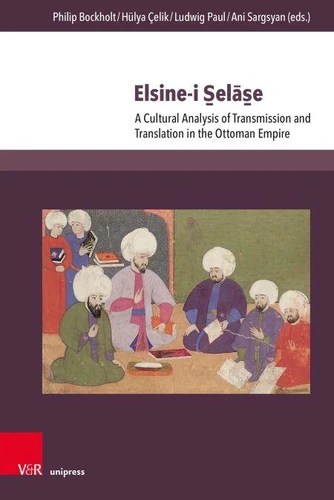Elsine - i S̱elās̱e. A Cultural Analysis of Transmission and Translation in the Ottoman Empire
Par : , , , ,Formats :
Disponible dans votre compte client Decitre ou Furet du Nord dès validation de votre commande. Le format PDF est :
- Compatible avec une lecture sur My Vivlio (smartphone, tablette, ordinateur)
- Compatible avec une lecture sur liseuses Vivlio
- Pour les liseuses autres que Vivlio, vous devez utiliser le logiciel Adobe Digital Edition. Non compatible avec la lecture sur les liseuses Kindle, Remarkable et Sony
 , qui est-ce ?
, qui est-ce ?Notre partenaire de plateforme de lecture numérique où vous retrouverez l'ensemble de vos ebooks gratuitement
Pour en savoir plus sur nos ebooks, consultez notre aide en ligne ici
- Nombre de pages198
- FormatPDF
- ISBN978-3-8470-1826-1
- EAN9783847018261
- Date de parution16/06/2025
- Protection num.pas de protection
- Taille5 Mo
- Infos supplémentairespdf
- ÉditeurV&R Unipress
Résumé
This collection explores the complexities of translation in the Ottoman Empire, examining the intersections of Arabic, Persian, and Turkish (elsine-i s_elas_e) that formed the linguistic backbone of Ottoman high culture and literature. The contributors investigate translation practices, cultural exchange, and power relations that shaped the Ottoman intellectual landscape, covering topics such as literary translations, lexicography, and the evolution of Ottoman Turkish as a lingua franca.
Focusing on the fifteenth to the nineteenth centuries, the articles reveal the intricate web of linguistic, cultural, and historical forces that influenced translation decisions, authorship, and readership in the Ottoman Empire, shedding new light on the dynamics of cross-cultural communication and knowledge transfer in pre-modern Eurasia.
Focusing on the fifteenth to the nineteenth centuries, the articles reveal the intricate web of linguistic, cultural, and historical forces that influenced translation decisions, authorship, and readership in the Ottoman Empire, shedding new light on the dynamics of cross-cultural communication and knowledge transfer in pre-modern Eurasia.
This collection explores the complexities of translation in the Ottoman Empire, examining the intersections of Arabic, Persian, and Turkish (elsine-i s_elas_e) that formed the linguistic backbone of Ottoman high culture and literature. The contributors investigate translation practices, cultural exchange, and power relations that shaped the Ottoman intellectual landscape, covering topics such as literary translations, lexicography, and the evolution of Ottoman Turkish as a lingua franca.
Focusing on the fifteenth to the nineteenth centuries, the articles reveal the intricate web of linguistic, cultural, and historical forces that influenced translation decisions, authorship, and readership in the Ottoman Empire, shedding new light on the dynamics of cross-cultural communication and knowledge transfer in pre-modern Eurasia.
Focusing on the fifteenth to the nineteenth centuries, the articles reveal the intricate web of linguistic, cultural, and historical forces that influenced translation decisions, authorship, and readership in the Ottoman Empire, shedding new light on the dynamics of cross-cultural communication and knowledge transfer in pre-modern Eurasia.



